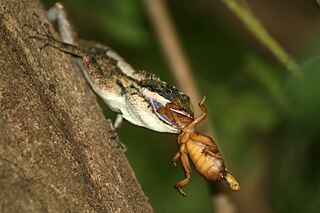
Calotes is a genus of lizards in the draconine clade of the family Agamidae. The genus contains 29 species. Some species are known as forest lizards, others as "bloodsuckers" due to their red heads, and yet others as garden lizards. The genus name Calotes has been derived from the Greek word Καλότης (Kalótës), meaning ‘beauty’, referring to the beautiful pattern of this genus.

Pseudocalotes is a genus of lizards in the family Agamidae. The genus is endemic to Southeast Asia.

Hardwicke's bloodsucker is an agamid lizard and found in South Asia.

Bronchocela cristatella, also known as the green crested lizard, is a species of agamid lizard endemic to Southeast Asia.

Calotes calotes, the common green forest lizard, is an agamid lizard found in the forests of the Western Ghats and the Shevaroy Hills in India, and Sri Lanka.

Monilesaurus ellioti, also known commonly as Elliot's forest lizard, is a species of arboreal, diurnal, lizard in the family Agamidae. The species is endemic to the Western Ghats, India.

Calotes emma, commonly known as the forest garden lizard or Emma Gray's forest lizard, is a species of lizard in the family Agamidae. The species is native to China, South Asia, and Southeast Asia. There are two recognized subspecies.

Calotes maria, called commonly the Khasi Hills forest lizard or Assam garden lizard, is a species of lizard in the family Agamidae. The species is endemic to South Asia.

Monilesaurus rouxii, commonly known as Roux's forest lizard, Roux's forest calotes, or the forest blood sucker, is a species of arboreal, diurnal, agamid lizard, which is endemic to hills of peninsular India. In July 2018, it was proposed that the species should be transferred to the new genus Monilesaurus.
Japalura andersoniana, Anderson's mountain lizard, is a species of lizard in the family Agamidae. The species is native to southern Asia.

Japalura tricarinata is a species of agamid lizard endemic to Asia.

Japalura austeniana, also known commonly as the Abor Hills agama or Annandale's dragon, is a rare species of lizard in the family Agamidae. The species is endemic to Asia.
Microauris is a monotypic genus of agamid lizard. Its only species is Microauris aurantolabium, also known as the small-eared dragon or orange-lipped forest lizard, found in the forests of the southern Western Ghats and is currently known from the Kalakkad Mundanthurai Tiger Reserve. The species was formerly included in Pseudocalotes andamanensis of the Andaman Islands, but recognized as distinct in 2008. It was also classified under Calotes until 2018, where it was transferred to its own genus, Microauris, on the basis of its divergence from Calotes.

Pseudocalotes andamanensis is an agamid lizard found on the Nicobar Islands and the Andaman Islands in India. It is also known as the green crestless forest lizard, Andaman and Nicobar forest lizard, Andaman lizard, or Andaman green calotes. This species is an almost exclusive canopy dweller, and is rarely seen.
Bronchocela smaragdina, also commonly known as Günther's bloodsucker, is a Southeast Asian species of agamid lizard.

Calotes ceylonensis, commonly known as the painted-lipped lizard or the Ceylon bloodsucker, is a species of lizard in the family Agamidae. It is one of four Calotes species endemic to Sri Lanka.
Diploderma dymondi, also known commonly as Dymond's japalure, is a species of lizard in the family Agamidae. The species is endemic to China.
Diploderma hamptoni, also known commonly as Hampton's japalure, is a species of lizard in the family Agamidae. The species is endemic to Myanmar.

Pseudocalotes floweri, also commonly known as Flower's forest agamid, Flower's long-headed lizard, and the Thai false bloodsucker, is a species of lizard in the family Agamidae. The species is native to Southeast Asia.
Calotes htunwini is a species of lizard in the family Agamidae. The species is endemic to Myanmar.













